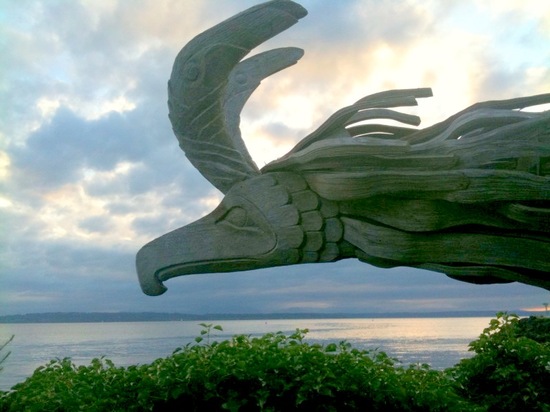We posted this scowling face last week when the Blue Angels were strafing Seattle, but it deserves the full back-story.
It would be Dudley Carter's final piece, painstakingly carved from driftwood washed ashore in British Columbia, assembled overnight so it could be exhibited from the bed of a flatbed truck in Redmond's 1991 Easter Parade; Carter himself, then 99, was the Grand Marshall. Then the piece was retired to Haida House, on the Bel-Red Road, where Carter lived and worked. He made one more public appearance that year, at the dedication of a minor work in Medina, and continued to teach. He was, after all, the artist-in-residence for King County Parks, a post he had assumed at the age of 96. And he continued to work, up at dawn, calisthenics, breakfast, carving. 10, 12, 14 hours a day, dressed in gabardine pants, long-sleeved wool shirt, wool cap, modeling his subjects first in clay to get the form down, then whittling the wood, a sliver at a time, with a three-pound, double-bitted, handheld ax.
Dudley Carter was born of Scottish stock in New Wetminster, BC., on May 6th, 1891, the third oldest of nine children. (Sergei Prokofiev was born two weeks earlier; Queen Victoria would reign for another decade.) Kwakiutl and Haida bands were still performing extravagant potlatch ceremonies, and European settlers were just beginning to log the region's huge stands of virgin forestland.
Carter grew up in a remote and rugged logging camp in the interior of British Columbia, where men measured their worth by the amount of timber they could cut and move to the mills. (No concerns about spotted owls back then; no schools, for that matter.) He was six when he got his first job, greasing the skids as oxen dragged the logs to the nearest railroad, seven miles away.
When Carter was in his teens, his father got a job as a trades instructor and the family moved to Alert Bay on the north end of Vancouver Island. They lived on an island among the Kwakiutl, where young Dudley observed their dying culture firsthand: their rituals, their art, their customs--including funeral rites and potlatches--and committed it all to memory.
"I come from another world," he told me, when I wrote a cover story about him for Eastsideweek in 1991. "You can't understand my art unless you know where I come from." It was a life spent in the woods. He worked for 20 years as a timber cruiser, measuring tracts of forest to determine their value. Not until 1930 did he turn up in Seattle, where he took second place in a soap-carving contest. At the age of 39, he had won a two-month scholarship to the Seattle Art Institute, the only formal training he would ever have.
But he had found his medium: monumental wood sculptures based on Native American myths and legends. Within two years, his career took off. He went to California for the 1939 Golden Gate International Exposition; he taught at the University of Washington. But with the arrival of World War II, the timber industry picked up and Carter returned to the woods. For the next three decades, he would alternate between sculpture and forestry.
Despite a steady stream of commissions (totem poles for shopping centers, large scale pieces for parks), and admiration from fellow artists, Carter had almost disappeared from public view by the 1980s. His wife, Teresa, had died in 1975; his daughter and grandchildren lived in Canada. His hearing was poor (rheumatic fever as a child); he lived alone in a log house he'd built himself, often eating nothing but apples for days at a stretch. Forced to move, he lived on nearby farms and in trailers. Frugal by habit, modest by inclination, he never sought public sympathy, but was grateful when the King County Arts Commission gave him a permanent home.
"Celestial Journey" was one of many pieces left to the elements after Carter died, a month shy of his 101st birthday. Eventually, it was purchased by Joseph Roberts, an attorney and patron of the arts, board member and curator of COCA (the Center for Contemporary Art) and president of Copper Canyon Press (one of whose poets, W.S. Merwin, was named Poet Laureate of the United States last month).
Today the sculpture sits outside the Shilshole Bay Beach Club, a private event venue shared with the Ballard Elks Lodge. The bird-like form looks west across Elliott Bay, brooding, like Milton's angel in Paradise Lost, over the vast expanse of sea and sky.

Leave a comment